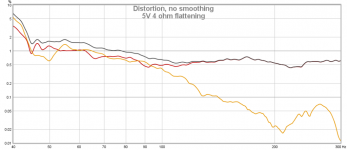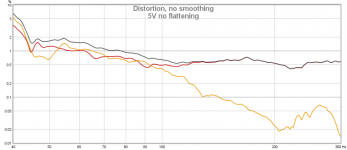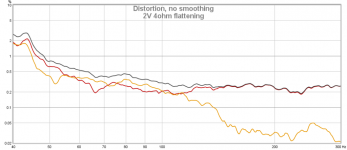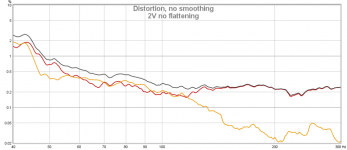Since the statement was a parallel resistor reduces the distorted current I don't see a need to wait that long.
I agree. As a small memory refresh, below are the results of distortion measurements at acoustical side with and without the "impedance flattening" resistor. In other words, NOTHING.
Attachments
Agreed. When you have a perfect impedance compensation, the transfer function is the same not matter what drive impedance, both with regard to speaker terminal voltage and thus acoustic output as well as amp input signal because the current drive amp has flat gain vs. frequency by this.I wasn't sure whether Joe is using current drive or not (he seemed to be saying it's no longer necessary with his developments), but now I remember one of the touted advantages of the zobels is that you get the same response in voltage or current drive. And yes I am aware that the zobels provide a current path for re-entrant distortion.
The difference is in the distortion behavior like you said but also in the damping. The voltage amp provides the "standard" Rg=0 damping, where as with current drive the damping is the impedance of the compensation, thus frequency dependent. And in some cases you certainly also can hit the sweetspot so the compensation approach is viable and quite easily to realize wrt to complexity.
Somewhat related to that, I actually agree with Joe that placing a series element (like inductor for woofers and capacitor/resistor for tweeters) as the last part in front of the driver is a good thing, for the simple reason it increases impedance the driver sees and thus can benefit from the reduced distortion with higher source impedance. For the same reason, don't pad down a tweeter with a resistor divider.
Joe,
You deserve an award for most likely breaking the DiyAudio Flux de Bouche record.
Just for fun I let my computer count the number of words you used over the last few days and the result is a staggering 6473 words, see image below 😀
Next time just try counting first person singular pronouns.
Reminds me of a classic joke:
2AM. A police officer sees a drunkard intently searching the ground near a lamp post and asks him the goal of his quest. The inebriate replies that he is looking for his car keys, and the officer helps for a few minutes without success then he asks whether the man is certain that he dropped the keys near the lamp post.
“No, I lost the keys in the park”
“Then why look here?”
“Because the light is so much better.”
2AM. A police officer sees a drunkard intently searching the ground near a lamp post and asks him the goal of his quest. The inebriate replies that he is looking for his car keys, and the officer helps for a few minutes without success then he asks whether the man is certain that he dropped the keys near the lamp post.
“No, I lost the keys in the park”
“Then why look here?”
“Because the light is so much better.”
Need both. It's all about the right stimulus and what Pavel did doesn't quite cut it. Yes, there is a trick involved, well maybe it should be called that, but you know what I mean. You know, if people were nice, things might be different, but don't you sense a bad vibe here? In football there is a saying, play the ball, don't play the man." Maybe you have to know a bit about football to understand it, I don't know. But it pretty much sums it up.
I agree both would be better, a more complete test. Can you not show what you have regards the parallel resistor current test?
I seem to remember that it is much easier to deal with common-mode noise from the Earth Rail in an amplifier if the load is a pure resistance.
You know, this sort of balanced thing:
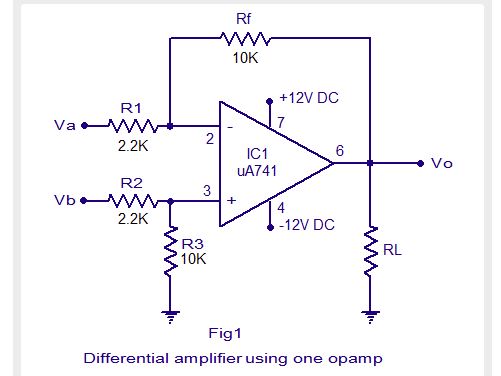
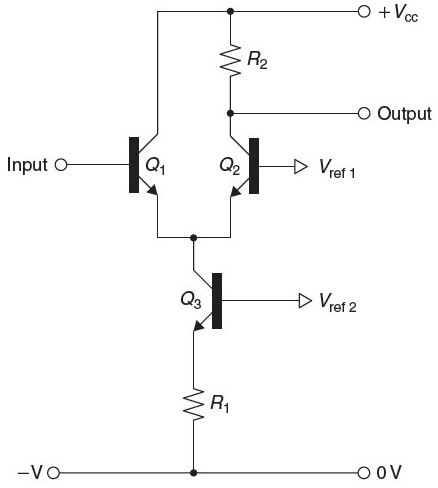
But I leave that to amp designers these days. Have other interests.
You know, this sort of balanced thing:
But I leave that to amp designers these days. Have other interests.
don't you sense a bad vibe here?
No. I sense the stench of malarkey, though.
Next time just try counting first person singular pronouns.
Are you one of the guys with an additional 8R on his amp ? 😀 😀
Hans
Actually, that is not what I am concentrating on. I am awaiting the delivery of a particular driver with a set of characteristics to be used for comparative testing with a driver that I have here. But considering the animous here, maybe I should add that you should not present a cake until it is fully baked. Might be the best cake on the planet, but it ain't any good until the time is right for the tasting.
I am talking about some fairly complex testing where a jig is required and more. The stimulus has to do more than one thing. I will give you a clue, adjusting an inductor is part of it.
Previously I prepared some quite complex posts, in fact, did it a number of times, and one particular post was repeated three times. They did not seem to 'want' to understand the implications they carried. But that was merely step one. Not even ready for that. It showed that proportional change in current gave proportional same dB change in SPL when a driver was compared under both current-drive and voltage-drive. It could be measured and calculated down into the milliAmp range and followed a precise mathematical pattern that even tracked the dissipation of the driver, I even gave the equations and how they matched on both the current side and the dB-SPL captured my microphone. And there was quite a bit more than that. It proved that it not only worked at frequencies dominated by inductive back-EMF, but also near the motional impedance at LF, the motional back-EMF.
But what it conclusive shows (and in Pavel's measurements, you can see this), that any change in current causes a change is the dB-SPL of the driver. So if you see distortion that is not on the voltage side of the amplifier, but it shows up on the current side, then you have current [of the amplifier] that has been corrupted by the load, basically the many imperfections of the driver. The corrupted current goes right back into the driver - and guess where it shows up? The microphone reveals it. Proportional current, in the form of distortion, is what you end up hearing. Current bad, sound bad.
What you hear is the difference between current-drive (because it resists the current of the amplifier being corrupted) versus voltage-drive (provided we have a like-for-like situation, which I know is difficult).
BTW, none other than Richard Marsh said he had heard the sound improve noticeably by adding a resistor. He said that many had heard it. Of course, measuring it is a challenge, but it is not much of a challenge for anybody to grab some resistors and actually give it a lesson. They might think "how do we get to measuring this?" But they won't even do that - listen, then measure, doesn't that make sense?
Cheers (as always), Joe
I am talking about some fairly complex testing where a jig is required and more. The stimulus has to do more than one thing. I will give you a clue, adjusting an inductor is part of it.
Previously I prepared some quite complex posts, in fact, did it a number of times, and one particular post was repeated three times. They did not seem to 'want' to understand the implications they carried. But that was merely step one. Not even ready for that. It showed that proportional change in current gave proportional same dB change in SPL when a driver was compared under both current-drive and voltage-drive. It could be measured and calculated down into the milliAmp range and followed a precise mathematical pattern that even tracked the dissipation of the driver, I even gave the equations and how they matched on both the current side and the dB-SPL captured my microphone. And there was quite a bit more than that. It proved that it not only worked at frequencies dominated by inductive back-EMF, but also near the motional impedance at LF, the motional back-EMF.
But what it conclusive shows (and in Pavel's measurements, you can see this), that any change in current causes a change is the dB-SPL of the driver. So if you see distortion that is not on the voltage side of the amplifier, but it shows up on the current side, then you have current [of the amplifier] that has been corrupted by the load, basically the many imperfections of the driver. The corrupted current goes right back into the driver - and guess where it shows up? The microphone reveals it. Proportional current, in the form of distortion, is what you end up hearing. Current bad, sound bad.
What you hear is the difference between current-drive (because it resists the current of the amplifier being corrupted) versus voltage-drive (provided we have a like-for-like situation, which I know is difficult).
BTW, none other than Richard Marsh said he had heard the sound improve noticeably by adding a resistor. He said that many had heard it. Of course, measuring it is a challenge, but it is not much of a challenge for anybody to grab some resistors and actually give it a lesson. They might think "how do we get to measuring this?" But they won't even do that - listen, then measure, doesn't that make sense?
Cheers (as always), Joe
Are you one of the guys with an additional 8R on his amp ? 😀 😀
Hans
Nah, I wouldn't know where to put it.
No. I sense the stench of malarkey, though.
That's just plain nasty. Is this how you get your daily fix? That is so sad.
I think it's worth mentioning that you average HiFi amplifier is a raft of unbalanced line compromises. Professional gear tends to use more expensive balanced-line techniques. Even bridged-mode has advantages.
All more theoretically optimised.
All more theoretically optimised.
That is so sad.
No, to a certain point is funny. You are well past that point, though.
Current drive can be advantageous, but I thought you were talking about something else? Where did Richard add the resistor? Putting it in parallel doesn't equate to current drive.But what it conclusive shows (and in Pavel's measurements, you can see this), that any change in current causes a change is the dB-SPL of the driver. So if you see distortion that is not on the voltage side of the amplifier, but it shows up on the current side, then you have current [of the amplifier] that has been corrupted by the load, basically the many imperfections of the driver. The corrupted current goes right back into the driver - and guess where it shows up? The microphone reveals it. Proportional current, in the form of distortion, is what you end up hearing. Current bad, sound bad.
What you hear is the difference between current-drive (because it resists the current of the amplifier being corrupted) versus voltage-drive (provided we have a like-for-like situation, which I know is difficult).
BTW, none other than Richard Marsh said he had heard the sound improve noticeably by adding a resistor. He said that many had heard it. Of course, measuring it is a challenge, but it is not much of a challenge for anybody to grab some resistors and actually give it a lesson. They might think "how do we get to measuring this?" But they won't even do that - listen, then measure, doesn't that make sense?
Cheers (as always), Joe
Richard probably added a small resistor as part of the negative feedback loop. This is not the same as just adding a resistor in series or parallel.
Thanks Joe for putting up this stuff. Almost nobody else will, because of the 'environment'. I find current drive interesting but impractical for me. Great for DIY, especially with multi-amp drives. We haven't discovered 'everything' yet!
Thanks Joe for putting up this stuff. Almost nobody else will, because of the 'environment'. I find current drive interesting but impractical for me. Great for DIY, especially with multi-amp drives. We haven't discovered 'everything' yet!
Bill, you still owe me an apology. Until then, expect nothing.
.
Best news I've heard in days 😀
- Home
- Member Areas
- The Lounge
- The Black Hole......
